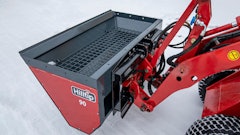
For most snow and ice management professionals, rust and corrosion are familiar foes. If not taken care of properly, corrosion can cause snowplows and spreaders to suffer from poor performance, structural damage, electrical issues and even system failures, but it can be preventable. Here are some tips to keep corrosion at bay and to keep your equipment in peak condition all season long.
Maintenance is Key
Being proactive is key to extending the life of your vehicle and winter attachments. Routine maintenance can reduce repair costs and most importantly, protect your bottom line. It will also improve the resale value of your equipment when trying to sell or upgrade your gear. Rust is the first thing a buyer sees, and it can leave a bad impression. So, when planning to face rust and corrosion head on, there are a few essential things to consider.
Equipment Inspection
At the beginning and end of each season, conduct a full inspection of your setup from plow mount to truck, giving careful attention to all attachment points. This will make you aware of any problem areas that need to be addressed right away, while identifying other potential concerns. The goal is to make sure there are no structural issues and that all equipment is in safe operating condition. If there are any worn or rusted parts, it’s best to replace those early to avoid a breakdown later. The best time to do this is pre- or postseason to avoid costly downtime.
Poststorm and Postseason Maintenance
“An ounce of prevention is worth a pound of cure.” The best thing to do throughout the season is to give your equipment a little care after each storm. A deep clean to wash all the salt off is critical to keep rust from starting and spreading. Make sure this is done in a warm, dry environment like a heated garage or shop. If there is any material left in your spreader, remove it after each use so it doesn’t turn into a brick and clog your spreader. Apply dielectric grease on all electrical leads, fittings and connection points to keep water and moisture out of your electrical system. This also creates extra insulation and ensures a strong contact for electricity to flow through while preventing arcing.
Safe Cleaning Materials
Using a “safe” soap to neutralize the chloride in salt will help to reduce corrosion. Once dry, apply an oil-based lubricant to coat the metal and sensitive parts to prevent salt and moisture from contacting any bare metal.
Fixing Chips and Scratches
If a chip or scratch is cosmetic, and surface rust has already formed, it could spread and bubble. You’ll want to address this throughout the season to prevent it from getting worse. It may seem tedious, but if you don’t take care of corrosion early, it will destroy your equipment over time. At minimum, touch up your equipment annually (postseason).
Equipment Restoration Tips
Rust in any form is not ideal, however, surface rust is more manageable than structural rust. Since it’s mostly cosmetic, there might be a slight impact on performance, but it doesn’t compromise the integrity of the equipment like structural rust will. You may just notice that it doesn’t throw snow as far or roll it as well as it used to.
The good news is that with a little time and effort, you can easily restore your equipment. First, scrape any trouble areas down to the bare metal. Next, it’s a trio of sanding the area, applying primer and then painting it. Here are a few additional tips:
- Be sure to get the entire area around the rust in case there are hidden, underlying spots. If you leave the edges, you will most likely have problems later and need to do this again, so it’s best to sand more than what’s needed to make sure you get everything.
- Primer is essential because it adheres to the metal and can help prevent chipping later on. This is an important step that can make a huge difference. Note: This is not the place to try and save time by skipping steps.
- If you’re doing a more in-depth restoration, you can also purchase sticker and decal kits to put the finishing touches on your work.
- If rust covers 25 percent or more of your equipment, we recommend taking it to a sandblaster to remove the entire layer of powder coat and rust. From there, you can start over with a clean blade. Cost varies depending on the job and market.
Finally, if you plan on attempting a restorative project, do it in the summer before the next season starts. It can be a strenuous project to undertake and not ideal to try while in season. Plus, if your efforts are unsuccessful and you need to buy new equipment, you’ll be ready to go well before the first snowfall.
Signs You Need to Replace Your Equipment
Once rust starts to eat away at the structure and frame, it’s no longer in safe operation and needs to be replaced. While these components are built to withstand brutal winters, significant and prolonged stress will cause damage over time and heighten the risk of it becoming a liability to you and your business.
Corrosion may cause the frame to no longer lift properly or remain level while in operation. This results in uneven wear, poor scraping ability, and a messy trail of snow left behind your plow. We strongly advise against trying to weld components back together. At this point, it’s too late. You risk catastrophic failures that may cause unsafe operating conditions.


























